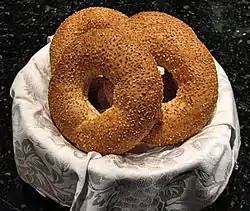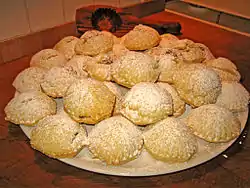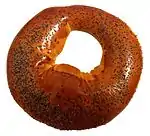Ka'ak
Ka'ak (Arabic: كعك, also transliterated kaak) or Kahqa is the common Arabic word for biscuit, and can refer to several different types of baked goods[1] produced throughout the Arab world and the Near East. The bread, in Middle Eastern countries, is similar to a dry and hardened biscuit and mostly ring-shaped. This pastry is popular in Indonesia, and called as "kue kaak".
 | |
| Course | Pastry |
|---|---|
| Region or state | Middle East, Persia |
| Main ingredients | Wheat flour, Vegetable oil, Eggs, Sugar, Black cumin or Sesame seeds, Egg yolk, Water, and Salt |
History
Ka'ak has been a staple since Roman times, although called by its Latin name buccellatum (= soldiers' biscuit).[2] In Hebrew, it was known by the name qanūḇqa’ot (Hebrew: קנובקאות),[3] and which were often baked to a crisp in an oven and could be ground back into flour and made into a gruel or paste and fed to babies.[4] In the early 11th-century, scholar and rabbi Hai Gaon described the ka'ak as being a hardened biscuit eaten usually as a dessert, and made dry, with or without spices.[5]
Variations
Bread rings

Ka'ak can refer to a bread commonly consumed throughout the Near East that is made in a large ring-shape and is covered with sesame seeds. Fermented chickpeas are used as a leavening agent.[6] Widely sold by street vendors, it is usually eaten as a snack or for breakfast with za'atar. In East Jerusalem, it's sometimes served alongside oven-baked eggs and falafel.[7] Palestinians from Hebron to Jenin consider Jerusalem ka'ak to be a unique specialty good, and those from the city or visiting there often buy several loaves to give to others outside the city as a gift.[8]
In Lebanon, ka'ak bread rings are made of sweet dough rolled into ropes and formed into rings and topped with sesame seeds. Instead of za'atar, after baking, it is glazed with milk and sugar and then dried.[9] Tunisian Jews also make a slightly sweet-and-salty version of the pastry, but don't use a yeast-based dough.[10] In Egypt, usually at wedding parties, a variation made with almonds, known as kahk bi loz, is served.[11]
A thirteenth-century Middle Eastern culinary text,[12] Kitab al Wusla il al Habib, features three recipes of ka'ak.[13]
Sweets

In some societies, the pastries or sweets known as ka'ak are semolina-based cookies (biscuits) such as ka'ak bi ma'moul (or ka'ak bi ajwa) which is stuffed with ground dates, ka'ak bi jowz which is stuffed with ground walnuts and ka'ak bi fustok which is stuffed with ground pistachios.
Ka'ak are popularly served for Eid al-Fitr and Easter in Egypt, where they are known as kahk. Kahk are coated in powdered sugar and filled with ‘agameya (عجمية, a mixture of honey, nuts, and ghee), lokum, walnuts, pistachios, or dates, or simply served plain. They are also decorated with intricate designs. Egyptians have made kahk since the Eighteenth Dynasty of Ancient Egypt, 3500 years ago.[14]
Arab Christians, primary among them Palestinian Christians (including those who live in the Palestinian diaspora) and Lebanese Christians, make these sweets to celebrate Easter.[15] The pastries are often shaped as wreaths and symbolize the crown of thorns that Christians believe Jesus of Nazareth was wearing on the day of his crucifixion.[16][17]

For the Muslim feasts during Eid al-Fitr and Eid al-Adha, ka'ak bi ma'moul is a traditional dessert as well.[18] In Gaza, when a neighbour sends a dish filled with food to your house as is often the case during the holidays, it is customary to return the dish filled with food of your own making, and most commonly with ka'ak bi ajwa.[19] The ka'ak sweets are also made year round among the entire Palestinian population and flour is sometimes substituted for semolina.
Ka'ak al-asfar ("the yellow roll") is a cake of bread that is made by Muslims in the Levant to honour the souls of the departed. Traditionally, this bread, stamped with an elaborate geometric design, was distributed along with dried fruit to the poor, to children, and to relatives, by the family of the deceased on the Thursday and Monday following the death and on a day known as Khamis al-Amwat ("Thursday of the Dead"). A bread stamp that was used to imprint designs on these cakes was discovered in Palestine and dates back to the fourteenth or fifteenth century CE. It is round, with a round handle and geometric designs, and measures 19 centimeters in diameter.[20]
Ka'ak sweets made by Iraqis are generally doughnut-shaped and covered in sesame seeds, such as ka'ak ab sumsum and ka'ak eem tzmukin, which has raisins among other ingredients. Ka'ak beharat oo tefach shares the shape and many of the same ingredients as ka'ak eem tzmukin, but substitutes apples for raisins and is coated in almonds instead of sesame seeds.[21] In Yemen, ka'ak was traditionally made with a sparse additive of black cumin (Nigella sativa).[22] Ka'ak was the traditional pastry eaten by the Jews of Yemen during the feast of Purim.[23]
See also
References
- Anthony B. Toth (March–April 1991). "On the Streets of Damascus". Saudi AramcoWorld. Retrieved 2008-03-14.
- Jerusalem Talmud (Hallah 1:4), where it is called בוקלטא; cf. Payne Smith, R. (1903). Jessie Margoliouth (ed.). A Compendious Syriac Dictionary (in Syriac and English). Oxford: The Clarendon Press. OCLC 251355373.
ܒܘܩܠܛܢ buccallatum, soldiers' bread
, p. 39 - Nathan ben Abraham (1955), "Perush Shishah Sidrei Mishnah - A Commentary on the Six Orders of the Mishnah", in Sachs, Mordecai Yehudah Leib (ed.), The Six Orders of the Mishnah: with the Commentaries of the Rishonim (in Hebrew), Jerusalem: El ha-Meqorot, OCLC 233403923, s.v. Mishnah (Hallah 1:5), הקנובקעות, כעכין
- Jerusalem Talmud (Hallah 1:4), Commentary of Rabbi Solomon Sirilio
- Nathan ben Jehiel, Sefer Arukh, s.v. כסן, British Library (Add MS 26881) [in Hebrew].
- "Food Composition Tables for the Near East". Food and Agriculture Organization of the United Nations: Food Policy and Nutrition Division. 1982. Retrieved 2008-03-14.
- Toine van Teeffelen (April 25, 2005). "The Crow Cries". Retrieved 2008-03-14.
- Winslow, 2007, p.118.
- Rinsky, 2008, p.151.
- Gardner, 2003, p.67.
- Maxwell, Fitzpatrick, Jenkins, and Sattin, 2006, p.85.
- Perry, Charles (1998). Medieval Arab Cookery. City: Prospect Books (UK). ISBN 0-907325-91-2.
- Roden, Claudia (1974). A Book of Middle Eastern Food. New York: Vintage Books. ISBN 0-394-71948-4.
- Fawzi, Essam (November 11, 2009). "Kahk: Cookies with history". Egypt Independent. Retrieved 15 May 2018.
- "Christian Holidays in the Arab World" (PDF). Alif Institute. Archived from the original (PDF) on February 6, 2007. Retrieved 2008-03-14.
- Saekel, Karola (April 4, 2007). "Two Easters in one: East Bay family's meal draws on ancient tradition". San Francisco Gate. Retrieved 2008-03-14.
- Paul Adams (March 30, 2002). "The lost city of David". The Globe and Mail. Toronto. Archived from the original on April 12, 2008. Retrieved 2008-02-14.
- Samia Khoury (January 8, 2007). "Dishes for Special Occasions". This Week in Palestine. Archived from the original on February 1, 2014. Retrieved 2008-03-14.
- Laila El-Haddad. "The Foods of Gaza". This Week in Palestine. Archived from the original on 2014-02-01. Retrieved 2008-03-14.
- "Three Faces of Monotheism: Bread Stamp". Bible Lands Museum Jerusalem. Archived from the original on 2008-03-25. Retrieved 2008-03-14.
- Goldman, 2006, pp. 161-163.
- Qafih, Y. (1982), p. 208
- Qafih, Y. (1982), p. 42
Bibliography
- Gardner, Adrian (2003). The F-14 Tomcat. Rosen Publishing Group. ISBN 9780823938704.
- Goldman, Rivka (2006). Mama Nazima's Jewish-Iraqi Cuisine: Cuisine, History, Cultural References. Hippocrene Books. ISBN 0-7818-1144-9.
- Maxwell, Virginia; Fitzpatrick, Mary; Jenkins, Siona; Sattin, Anthony (2006). Egypt. Lonely Planet. ISBN 9781740597418.
- Qafih, Y. (1982). Halichot Teman (Jewish Life in Sanà) (in Hebrew). Jerusalem: Ben-Zvi Institute. ISBN 965-17-0137-4. OCLC 863513860.
- Rinsky, Laura Halpin (2008). The Pastry Chef's Companion: A Comprehensive Resource Guide for the Baking and Pastry Professional. John Wiley and Sons. ISBN 9780470009550.
- Winslow, Philip C. (2007). Victory for Us Is to See You Suffer: In the West Bank with the Palestinians and the Israelis. Beacon Press. ISBN 0-8070-6906-X.

